The kouign amann, a flaky buttery caramelized sugar filled pastry, is easy to make if you follow my step-by-step photo instructions!
I was in New York the first time I took a bite of a kouign amann, a yeasted buttery flakey caramelized sugar filled pastry who’s origin came from the Brittany region of France. I had flown into the city for a few days as a quick layover before I headed up to Pennsylvania for the Big Summer Potluck, one of my favorite food blogging events. While hanging out with fellow East coast food bloggers at the Potluck, I asked them for suggestions of places to eat and things to check out while in New York. Of course, the laundry list of “must have” food items was immense (note to self, never ask food bloggers for restaurant suggestions, you’ll get an immense list and you’ll never be able to get to all of it). But the one item that kept on being mentioned by everyone was Dominique Ansel’s kouign amann. Otherwise known as the DKA (Dominique’s Kouign Amann) it was the it pastry to try at the time, until it ended up being eclipsed by his now even more famous creation, the Cronut®. (Jump directly to the recipe.)
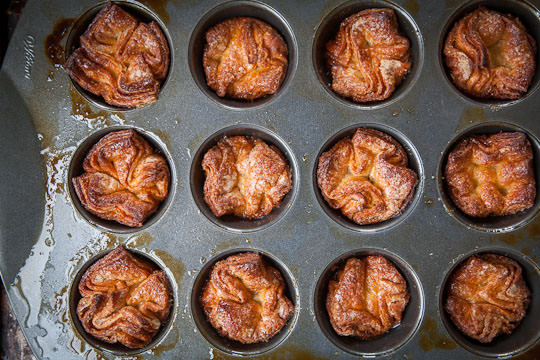
Once I was back in the city after the blogging event, I headed over to meet my friend Gail of One Tough Cookie at Dominique Ansel. I adore that woman but we had actually never met in person. Gail turned out to be even more fabulous in real life that I imagined and we caught up talking person-to-person chatting about baking, about food blogging and about which food blogger’s online and real life personalities were the same and which were vastly different. All the while, we nibbled on various different pastries, including the famed DKA. Turns out the pastry that literally translates to “buttery cake” lived up to it’s hype.
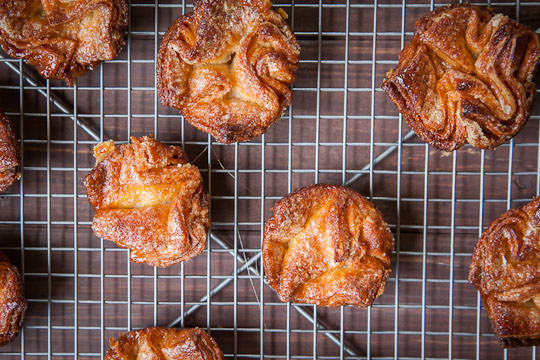
Of course, back in San Francisco I started to see kouign amanns popping up here and there. But it wasn’t until I took my laminated dough pastry class at the San Francisco Cooking School that I made one for myself. Of the three different doughs that we worked on in the class (croissant dough, puff pastry dough, and kouign amann dough) it was by far the easiest. But in the back of my head, I knew that I wanted to make it even easier at home. With the confidence and skill set that I got from the class and a little help from the cookbook The Modern Baker by Nick Malgieri, I was able to come up with a recipe for the kouign amann that pretty much anyone could make. even if the idea of laminated dough scares you. If you can make a pie crust, you can make my kouign amann!
Kouign Amann Recipe, the easy and fast way
By Irvin Lin
A sweet and flaky pastry that originates from the Brittany region of France, the Kouign Amann (pronounced “kween-amahn”) can be found in a lot of upscale pastry shops nowadays. But making it at home is fairly easy, even if you go the traditional route by making a butter block (it was one of the easier doughs we made in our laminated dough class). I decided to simplify and streamline the recipe even more by using a technique I learned from Nick Malgieri that combines blitz puff pastry and croissant dough. Basically, if you have a food processor and know how to make pie crust, you can make a kouign amann. But even if laminated dough freaks you out, don’t worry, I’ve included step-by-step instructions and extensive photos on how to create this awesome pastry that will not only impress your friends but have your loved one clamoring for one more.
One thing to note, this recipe calls for salted butter. If you don’t have salted butter and only have unsalted butter, just add an additional 1/2 teaspoon of sea salt to the recipe but I suggest just buying some good quality salted butter for the recipe as salted butter has a particular funky salty sweetness that really works well in the recipe.
Recipe drastically adapted from Nick Malgieri’s The Modern Baker and Chef Nicole Plue of San Francisco Cooking School
Ingredients
1 package (2 1/4 teaspoon or 7 grams) active yeast
1/2 cup (105 g) lukewarm water
1 3/4 cup (250 g) bread flour
1 teaspoon (5 g) sea salt
14 tablespoons (1 3/4 sticks or 190 g) cold salted butter, divided (see note above)
1/4 cup (35 g) cold water (from the tap)
3/4 to 1 cup (150 to 200 g) granulated white sugar
Special Equipment
Food Processor
Rolling Pin
Pastry Brush
Metal Ruler (optional but recommended)
Bench scraper (optional but recommended)
Standard 12-cup muffin tin
Wire cooling rack
Directions
1. In glass measuring cup or small bowl, dissolve the yeast into the warm water. Let sit for 5 minutes, until the liquid starts to bubble.
2. As the yeast liquid proofs, place the bread flour in the bowl of a food processor. Add salt and pulse the dry ingredients a few times to blend the salt in. Add 4 tablespoons (1/2 a stick or 57 g) of the butter, cut into 1/2 inch chunks, and pulse until the butter is chopped into small bits and mixed into the dry ingredients (it’s OK if some of the butter is visible, but try to reduce them into small pebble size if possible).
3. Cut the remaining butter into 1/2 inch chunks and add them to the food processor bowl. Pulse 2 times (yeah, there’ll totally be big fat chunks in the bowl, that’s OK). Add the cold water to the warm yeast liquid and mix together. Pour it into the food processor and pulse 3 times. Again, there will still be big chunks of butter and a dough will NOT form. That’s normal.
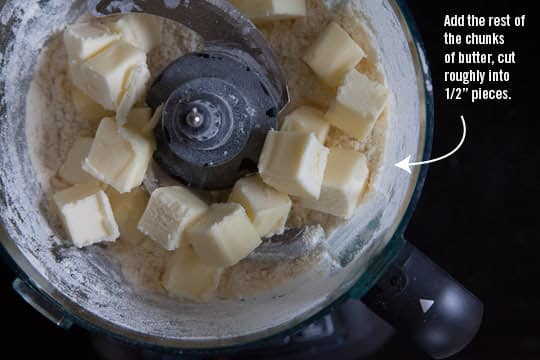
4. Empty the entire content of the food processor on a clean surface well floured with all-purpose and carefully (don’t cut yourself) remove the blade. Gather the dough into a ball with your hands (forming the dough by pressing it all together firmly), then push it on the surface and shape it into a rough rectangle. Toss some more flour under the dough and, with a rolling pin, roll the dough into a 12 x 15 inch rectangle with the long side facing your (it should be in landscape orientation). Try to make the rectangle edges and corners as even and square as possible. You’ll notice that there are streaks of butter in the dough. That’s totally cool. If the butter gets warm and sticky, just dust it with flour.
5. Brush as much of the flour off of the dough with a pastry brush (or just blow on it if you don’t have a brush). The more dry flour that is on the dough, the harder it is for the dough to laminate. Fold the dough a third of the way DOWN into the center (this is where a bench scraper would be handy, but you can do it without). Brush off any flour from the bottom of the dough that you just folded over. Then fold the dough from the bottom side up and over your initial dough fold, as if folding a really long skinny letter. Brush off any flour that you can. You should have three layers and a really skinny 4 x 15 inch rectangle.
6. Now take one end and roll the dough, as if it you are forming a huge cinnamon bun. Brush the dough as you roll it, trying to get as much flour off the dough as possible as you roll. You should end up with a tall skinny roll. Flatten the roll from the top-side down, flattening all the layers, with the palm of your hand. Stick the flatten dough in a gallon ziplock bag and seal it. Let it rise for 30 minutes at room temperature. Once the 30 minutes are up, squish the dough down (it won’t rise much but it will feel a little squishy) with your hand through the ziplock bag and place it in the refrigerator. Let rest in there for 1 hour or overnight (I did overnight because of time constraints).
7. Once the dough has rested and chilled, generously spray a standard 12-cup muffin tin with cooking oil. Place on a rimmed baking sheet. Sprinkle about 6 tablespoons of sugar on a clean surface and pull the dough out and place it on the sugar. Sprinkle 6 tablespoons of the sugar on top of the dough and roll the dough out into a 21 x 15 inch rectangle. Use the remaining 1/4 cup of sugar to roll the dough out if it starts to stick at all (basically, instead of using flour to roll the dough, you’re using sugar). Try to get the rectangle edges and corners as square as possible.
8. Once you’ve formed the rectangle, fold 1/3 of the dough from the right side to the center. Fold the left side over the two layers of dough, forming three layers, and a 7 x 15 inch rectangle. Roll triple-layer dough out a bit, flattening it until you have a 13 x 15 inch rectangle. Now trim the edges of the rectangle by a 1/2 inch on all sides with a sharp knife. Use a metal ruler if you have one, or just free form it, cutting evenly in one smooth motion. Don’t saw back and forth. You should have three layers of dough with no folded edges that is about 12 x 14 inches.
9. Now cut the dough into 3 x 3 1/2 inch squares; 3 rows and 4 columns. Take each square and “pinch” the dough inward with your fingers and place in the prepared muffin tin. Repeat with the remaining dough. Cover the muffin tin with plastic wrap and let sit at room temperature for 40 minutes. About 25 minutes into the rise, turn the oven on to 400˚F to preheat it. Once the 40 minutes are up, the kouign amann dough should look puffy (but it won’t have risen much). Take the plastic wrap off and place in the oven. Reduce the heat to 350˚F and bake in the oven for 45-55 minutes, or until the edges of the kouign amann are nearly burnt black. Using two butter knives or forks immediately remove the kouign amanns from the muffin tin to a wire cooling rack. Do not let them sit very long in the muffin tin, as they caramelized sugar will start to cool and harden and stick to the pan. Let cool on wire rack and serve.
Makes 12 kouign amanns.
If you want to go the more traditional route with making the kouign amann, check out some of these other recipes for kouign amanns from around the web:
David Lebovitz’ Kouign Amann Recipe
The Kitchn’s How to Make Kouign Amann at Home
Use Real Butter’s Kouign Amann Pastry Recipe
Desserts First Kouign Amann with Praline Noisette
Joe Pastry’s Kouign Amann recipe
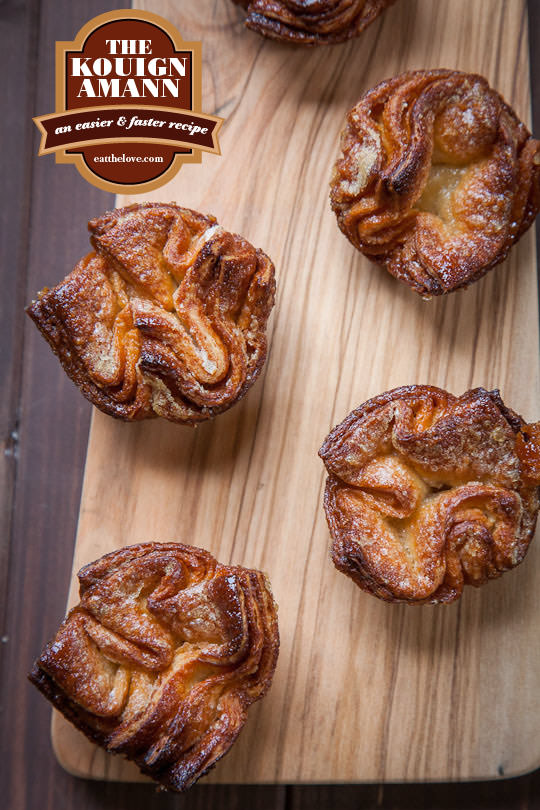
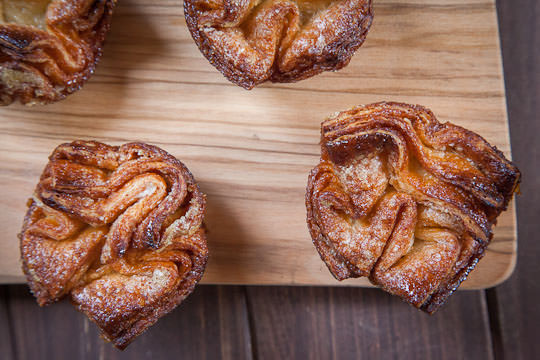
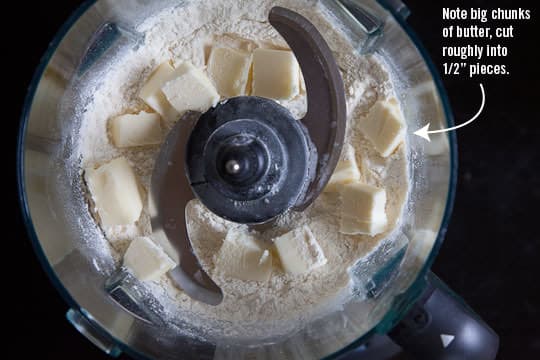
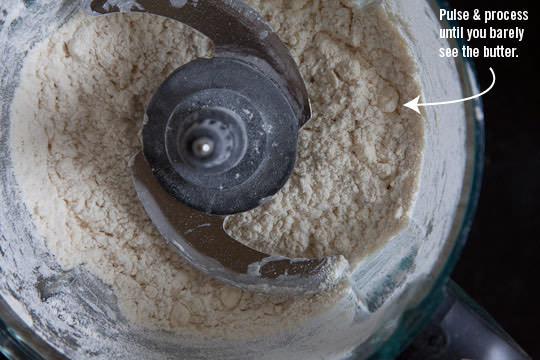
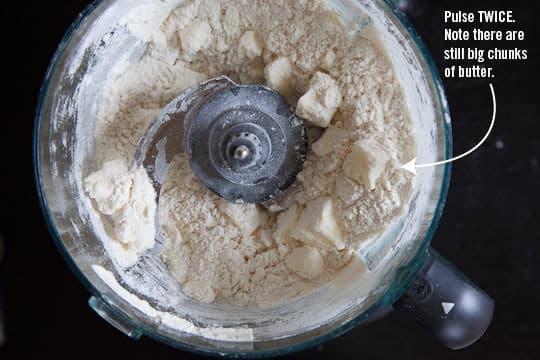
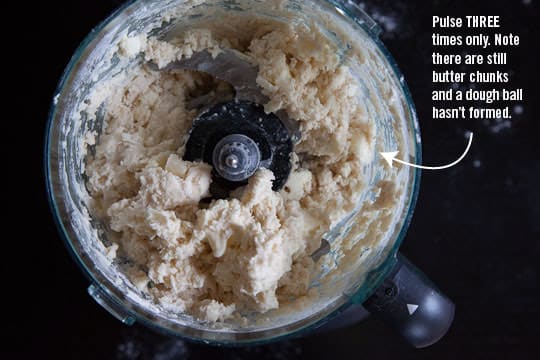
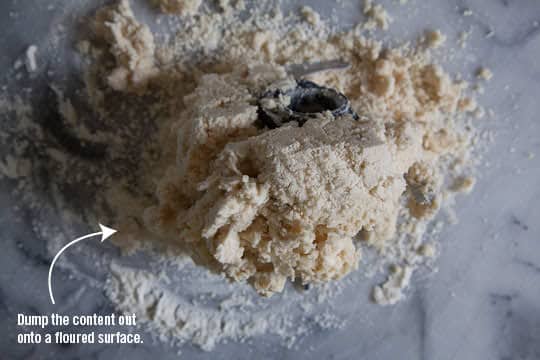

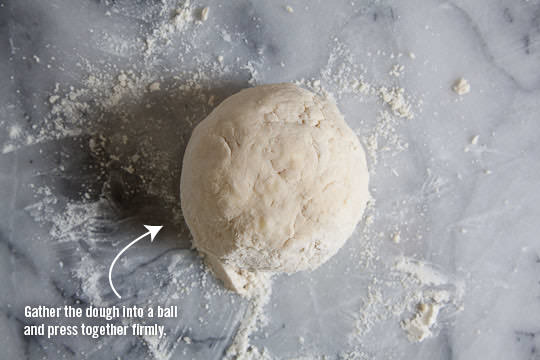
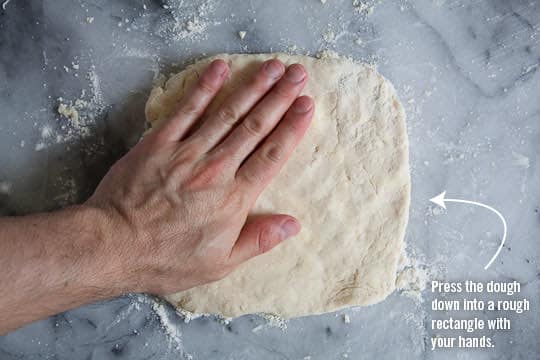
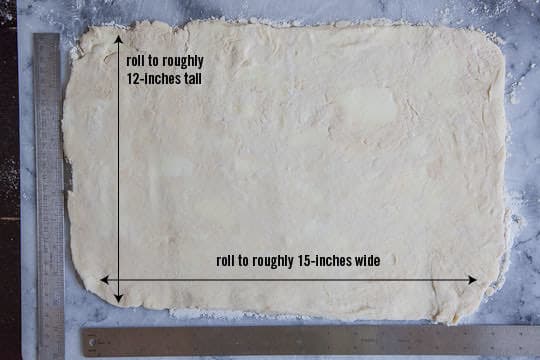
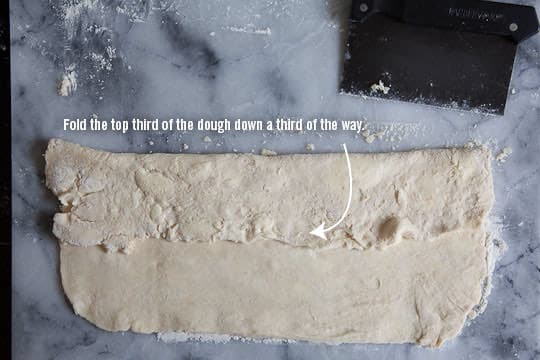
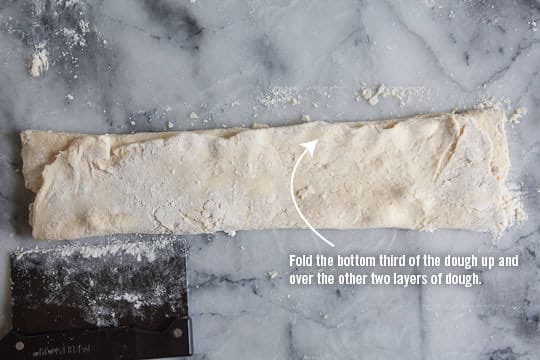

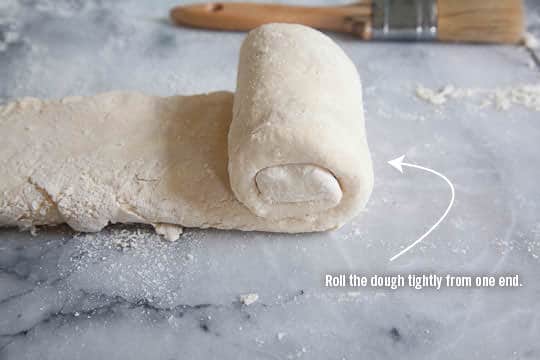
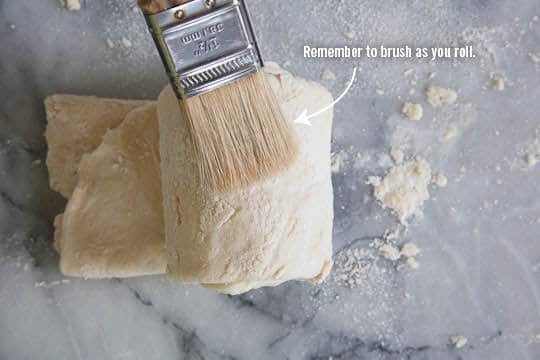
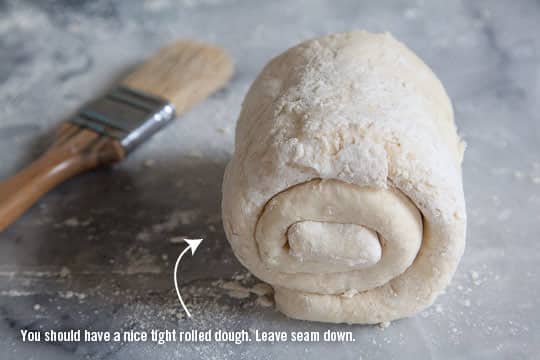
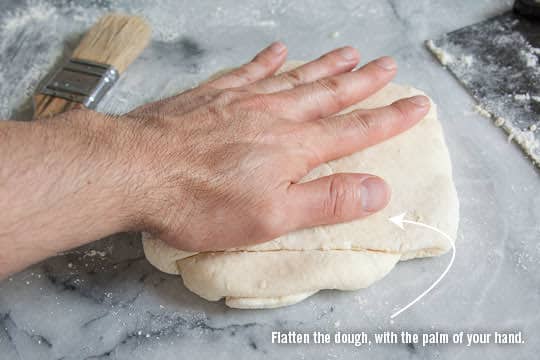
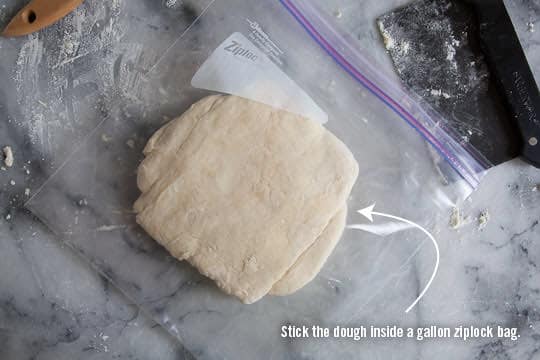
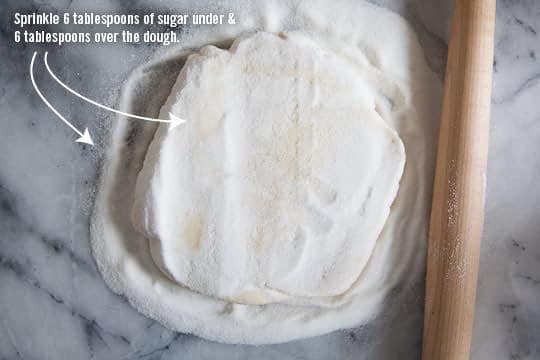
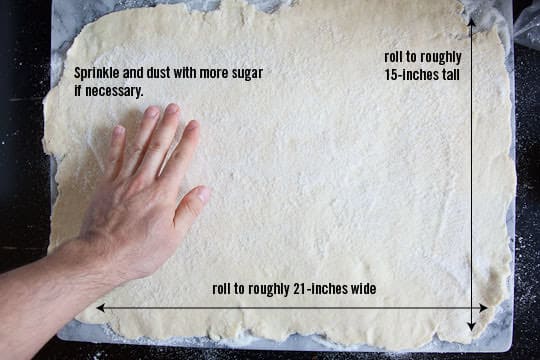
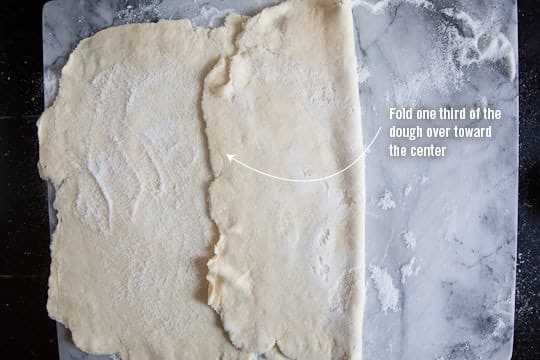
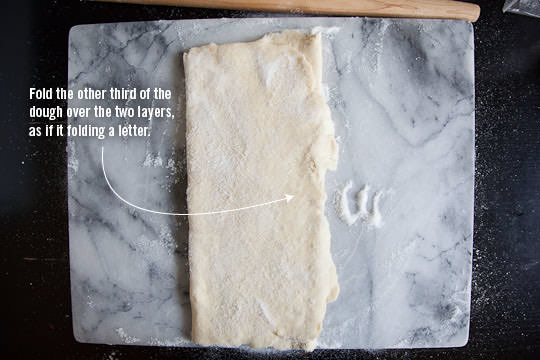
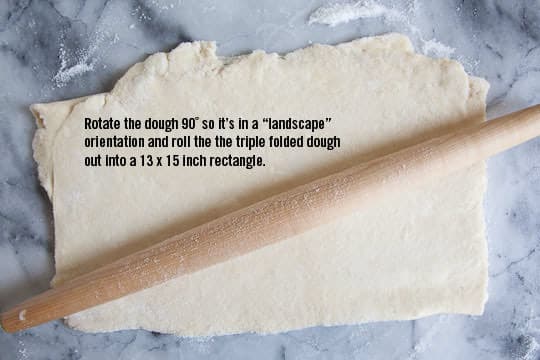
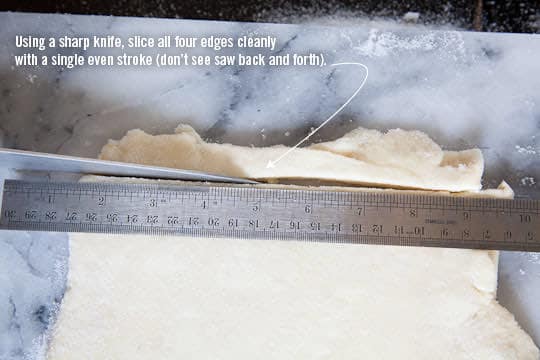
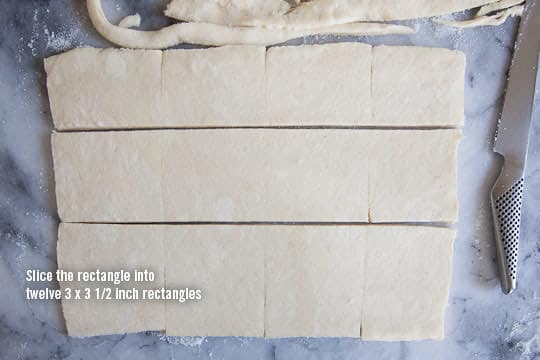
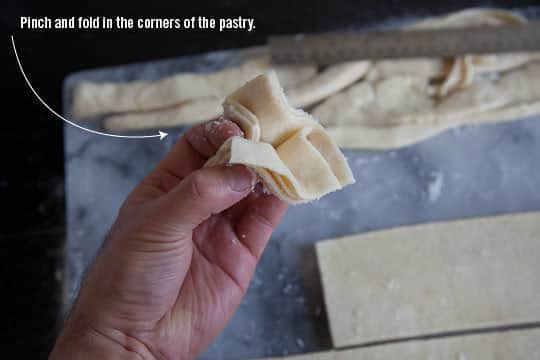
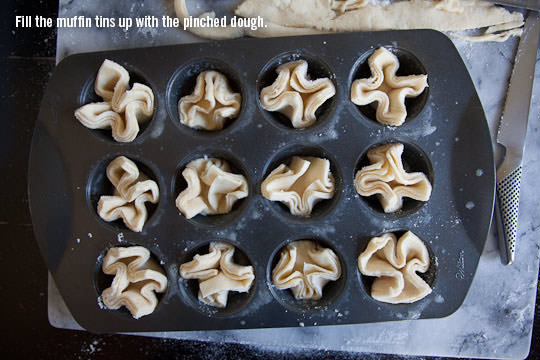

Belinda @zomppa says
These are stunning and probably completely irresistible. When are you opening up your bake shop??
Irvin says
Ha! Never. Too much work!
Shikha @ Shikha la mode says
I have that book! I got in the blogger cookbook swap a few weeks ago and it’s fabulous – I made a babka from it and it was so good. I remember seeing this recipe in the book – how/did you adapt it?
I’m going to France this year too and I’m about to stuff my face with croissants and kouign amans.
Irvin says
The recipe technique of using the food processor and rolling the dough is actually adapted from his croissant recipe. The kouign amann recipe in the book produces more of a cake and not a flaky pastry, which is what most people are more familiar with (and what I was taught in the laminated dough class).
I’m totally jealous you’re going to France! How awesome. I’ve never been!
Katrina @ WVS says
You are so talented! I absolutely love the look of these 🙂
gretchen | kumquat says
these are beautiful… love the recipe and the step by step is priceless!
Annalise @ Completely Delicious says
There’s a local bakery in SLC that is famous for its kouign amann, and for good reason. I’ve always wanted to attempt it on my own, but have never given it a try because of how labor intensive laminated dough can be. So, I’m extremely excited about this version, and love all of your ingenuity! Totally jealous of that pastry class you took, by the way.
The Suzzzz says
Annalise, are you talking about Gourmandise? I love that place.
Heidi @foodiecrush says
The bakery is Les Madeleines and was written up in Food & Wine for their kouign amanns. They are to die for. But I am totally rolling up my sleeves and trying this! Annalise, we need a baking day!
Nicole Pyne says
They are amazing!!!!!
tmartinpc says
Eva’s Boulangerie in downtown SLC makes these every day, and every day I am in SLC I make it point to stop by and buy a couple for the next morning. I am eager to try Irwin’s recipe, but will also try some of the other, laminated dough recipes to find the balance btwn technique, texture, and taste.
Gail says
You know what, Irvin? I can’t look at a Kouign Amann w/o thinking of you.
What a GORGEOUS recipe!
I love laminated doughs….I don’t get to make them nearly as often as I’d like.
TOTALLY filing this one on the top of my ‘to make’ list.
xoxo
Irvin says
Ha! I LOVE that Gail! One of these days I want to bake with you…
Debbie D says
Laminated doughs have scared me to death! Everything else I can make just fine. Have wanted to take a laminated dough class so someone could walk me through it the first time. Your blog and fabulous pictures have done just that! I LOVE Kouign Amann. I swear it is an edible form of crack! I think I may be trying this, this weekend. Thank you so much!!!
Kathleen says
In the last month I have made two attempts at KA with so-so results…here’s hoping with your method the third time is the charm!
Irvin says
Let me know how this method turns out for you, compared to the other time. I’m curious to see how it compares…
Baking Outside the Box says
I have always wanted to try making these! The bakery downtown sells them for a fortune. I would love to serve them up in my own kitchen. Thanks so much.
The Suzzzz says
I’ve never had much luck with laminated pastry but I’m going to try this recipe when I have time either this weekend or next., whenever I can borrow my sister’s food processor. I just hope I can get it to rise.
Karen @ The Food Charlatan says
What an amazing and thorough tutorial!! Thanks Irvin! They are beautiful.
Kathy - Panini Happy says
I would love to bite into one of these right now — they look incredible, Irvin!
nicole plue says
Lin. Malgieri. Plue: I like it! They look delicious!
Irvin says
Thanks Nicole! I had a blast in your class and it was SO incredibly informative. Thanks for stopping by my blog!
Jennifer Hodge says
Wow! I just found your site, I love it. Its beautiful. What type of camera do you use? And what would you recommend to a newbie? Thanks so much.
Irvin says
I shoot on a Canon 5DMkII but it’s probably overkill for a newbie. I’d recommend an entry level dSLR camera like a Canon Rebel T3i for someone just starting out. But to be honest, you can take great photos with nearly any camera nowadays, even an iPhone or Android. I think it’s more about paying attention to the styling of the food and the light more than the equipment that makes a great photograph. I’ve always said that and most professional photographers agree.
After all, you don’t need a fancy stove or oven to make fabulous food. Same goes for photos!
dina says
they look wonderful!
Lillian @ sweets by sillianah says
This is amazing, Irvin! A few blogger friends and I got together this past summer to learn how to make KA from a friend who works in a bakery and they taste so much better than the DKA (shhh!). But the method seemed much more complicated – you make the KA look so do-able! The step-by-step tutorial/photos really help, maybe we’ll attempt it again using your method. The cupcake pans are genius – my friend went out and bought pastry rings b/c she wanted to make KA at home… I’m glad I waited! lol 😉
Nina Russell says
Thanks for a wonderful tutorial. I can even get all the recipe ingredients in Australia, which I must say is very hard when trying to follow an American recipe.
Thanks again.
Irvin says
You’re most welcome!
Alicia says
Must eat now! That looks so fun to make and delicious. This looks like the kind of recipe that once you get the hang of it could really take the stress out of your day.
Irvin says
I have to say, after taking that laminated dough class, I can totally see why my friend Krista (who is a food stylist) told me that laminated dough is like a zen project for her. Pounding the butter and rolling out the dough really works out the stress and puts you in a great mood. Well, it did for me at least!
Faye says
Totally scared, but I’m going to try it!!! Hope they turn out half as gorgeous as yours!
Irvin says
Let me know how it turns out!
Huma says
Thanks for sharing.bookmarking it.
Can I substitute instant yeast for dry?
Irvin says
You should be able to but I’ve not tested the recipe with instant, so I can’t guarantee it. Instant yeast is actually what we used in the laminated dough class and it came out great going the traditional route. Try it with the instant yeast and let me know!
Aimee @ Simple Bites says
Incredible tutorial!! I’m confident the home baker could make these. Gorgeous, Irvin!
Wow says
In your “trim the edges of the rectangle by a 1/2 inch on all sides with a sharp knife” step, have you ever tried using a pizza cutter (wheel) for this? I find it much easier for cutting pastry. You can’t stretch the dough or saw at it. It’s also awesome for cutting lattice pie crusts.
Irvin says
I asked that question to Chef Nicole Plue actually and she said no, but I have totally seen bakeries use pizza cutters to make their croissants so I’m going to say yes. In fact high volume bakeries have those awesome contraptions which are basically multiple pizza cutters attached together so you can cut 6 parallel lines in a row.
The only caveat is that your pizza cutter should be sharp. If you have a dull pizza cutter, then it will crush the layers together instead of cutting the layers. One of the problems is the average baker (if they even have a pizza cutter) probably wouldn’t bother to get the wheel sharpened. But if you’ve had good luck with yours, then it’s probably pretty sharp and I say go for it!
Alice says
I’ve been through a laminated dough course at school, but I’m yet to try the Kouign Amann. Your method has totally got me inspired. Those beautiful layers of both sugar encrusted dough and butter short crumbs have got to be worth mastering!
Michele says
Where have you been all my life, you just made this kind of dough so approachable!
Gerry @ Foodness Gracious says
Fantastic! I’ve tried these and love the flaky, chewy, crispiness. You make me want to put on my pastry boots now and get busy in the kitchen 🙂
Faith says
Hi Irvin, this is probably a silly question. Just wanted to check the “well-floured clean surface” is referring to all-purpose flour or bread flour? I’d really love to try this recipe out! 🙂
Irvin says
Good question! I use all-purpose but I don’t think it’ll make much difference if you use it or bread flour. But I went ahead and updated the recipe above to clarify!
Faith says
This is awesome, thanks! I’m working on it now.. will let you know if it’s successful for me! 🙂
Faith says
Hi Irvin, it was successful and it tastes really good! Thanks for sharing the recipe and my craving for Kouign-Amann is now satisfied! 🙂
Irvin says
Yay! I’m glad you liked it and they turned out! Thanks so much.
cynthia says
Oh my Heavens!! I wish I had come across your recipe yesterday before I tried..and I mean “tried” the more traditional recipe which took me literally all day and with questionable results. They did not glean ohs and ahhs. As soon as I get over the trauma of this experience, I will definitely try again with your gorgeous and user friendly recipe!!
Irvin says
Let me know if you do attempt it again and how it turns out for you! I love making kouign amann’s the more traiditional method but this short cut method takes half the time and I think the results are (nearly) as good!
Gabe says
Hi,
Nice article.
Those are “Kouignette” , little kouign amann. The cake is actually the size of a plate.
Is it getting popular among americans or it’s still only known to “baking experts” or food travelers?
thanks
Irvin says
Hi Gabe, that’s so funny! I have actually never heard the term Kouignette before. All the Kouign Amanns I’ve found here in the US at bakeries are the smaller type that I made. The large plate size cakes you mention I’ve only come across on the internet but never in a bakery here.
I wonder if its a case of American mistaken identity or something (ie. American bakeries are just taking the name Kouign Amann and using it for Kouignette because they like the name Kouign Amann better).
I know that I’m seeing them more and more in bakeries here in the US. They aren’t as popular as cupcakes or croissants, but most upscale French inspired bakeries that I’ve visited seem to have them. There’s even a few regular coffee shops and cafes here in San Francisco that I’ve seen them in. They don’t make them in-house of course, buying them from other bakeries, but they must be popular enough to stock and sell them!
Gabe says
Hey Irvin,
The name kouignette is unformal. Actually, growing up in the 90ies, I can’t recall having “kouignette”, you would go to a bakery and get a slice of the big cake (square shaped).
I guess the kouignettes generalized, especially in Paris, as the demand grew, it was prolly more convenient for customers and bakers than the big cake. So I’m not sure if the term even existed while it arrived in the States. There is a subtle nuance though, I found that the heart of the big cake is softer than the kouignettes. Also,The crust is smoother.
Thank you for the recipe!
Klaus Hornell says
The first time I had Kouign Amman was about 2 months ago while visiting my parents in Pittsburgh, Pennsylvania. While not a huge city, Pittsburgh does boast a fabulous French bakery opened by a native of Bretagne. After returning to Los Angeles, I embarked on a search to find this delicacy. Living in the San Gabriel Valley in Los Angeles county, bakeries offering true French fare are few and far between. I am so thrilled to find your posted recipe and particularly the pictures. They will be by my side as I attempt to create this wonderful pastry. Wish me luck
Klaus
Pat says
I have tried making these in the past and it was a huge mess. Butter and sugar went all over the bottom of the oven, which sent out billowing smoke. I saved a few that I continued to bake in a toaster oven, which severely burnt the tops. However, the taste was incredible. This recipe used a butter block instead of your method. I cannot wait to try your process with the food processor instead! Thanks for a viable alternative!
Irvin says
Let me know if you make them this way and how they turn out! One thing I might suggest is whatever method you use, you might want to place the muffin pan on a rimmed baking tray when you bake them. That way anything that spills out over the muffin pan, will fall onto the baking tray and not the oven bottom. I’ve even been known to line my baking tray with aluminum foil. That way if there is any spill, I can just toss the foil and not even have to clean the pan!
Pat says
Thanks Irvin,
YES SUCCESS! Something so simple as a tray under the muffin tins. They tasted wonderful. Also, I made 2 batches. One was the regular size muffins and the other, I made 24 muffins in a mini muffin tin. I wasn’t sure how to long to bake them, so I started with 20 minutes and kept adding 5-minute increments. It was about 30 minutes in the end. I am going to try a savory version next. Something like spinach or kale and feta. Thanks so much for such a wonderful recipe to add to my repertoire!
Pat
Elise says
Thank you for the recipe!!! I planned and planned to make kouign amann … but it’s too labor intensive. So I found your recipe a few days ago.. .and I am eating one right now. Delicious.
Irvin says
Excellent! I’m so glad you found it delicious!
Lyndsay // Coco Cake Land says
eeks! love the step by step photos – this totally seems do-able, and yours turned out soooo delicious looking! thank you for sharing this insanity!! xo
Mimi says
I have to say. When I first saw the recipe instructions for various ways to make a Kouign Amann, I was MORE than intimidated – not only about working with yeast (which is temperamental), but also the TIME involved in this. But I did it today (6/28/14), and I just wanted to thank you for the step-by-step instructions! I made a few flubs along the way, but the end result was a flaky on top, buttery soft in-the- middle roll, with just the right amount of crunch and chewiness. Thanks, again. Now, I have gotten over my fear of working with layered pastries and laminated dough! Kudos! 😉
Irvin says
Yay! I’m so glad. I think my method is easier than a lot of other recipes out there, especially with the use of the food processor. I’m glad you got over your fear of laminated dough and yeast! Whoo hoo!
Kirbie says
I’m obsessed with kouign amann after having it in NYC at Dominique Ansel’s~ I tried so many other versions and found it disappointing. If you are in SF though, b patisserie makes one that is equally as good as DA’s version. I can’t wait to try out your recipe.
Irvin says
I’ve had Dominique Ansel’s KA in NY and you’re right, it’s fabulous. And yes, the b patisserie version is awesome as well. My version is a slight “shortcut” version and won’t yield as flaky a version as b patisserie, but there’s something really satisfying about eating a homemade one, and I think my version is great in a different way. Let me know if you try it and what you think!
honolulubaker says
Trying to make this today…after having one from Thomas Kellar’s Bouchon Bakery, we are hooked!…
The recipe says prepared muffin tin….what preparation are we supposed to do…sorry I’m very literal and from the review, looks like this works…so want to find out what I need to do.
Butter? Sugar?
Thank you!
honolulubaker says
Please disregard my previous comment….found it..I’m so excited to make it…so it’s in the fridge..and then I saw “spry muffin tin”…thank you
Chef Dan says
Brilliant idea adapting the process of a quick puff pastry to the yeasted version for kouign amann. I already started a batch using the ChefSteps recipe today (to be finished tomorrow) but I may try this one as well some time. Looks to be a lot less labor-intensive, so if the results are almost as good, why not?
Janice Leiser says
Hi Irvin
I just got back from Brittany where I sampled several Kouign Amann and am excited to try your recipe. Just been home two days and already checking out recipes. I made David L’s recipe several years ago and it was fabulous. At the Saturday market in Rennes I saw lots of Kougin Amann but was particularly interested in the little ones, which I should add were yummy.
Do you use a standard size muffin tin with straight sides? I’ll be checking your blog out since I live in the east bay. Any suggestions where to buy Kougin Amann in SF or Oakland area? Thanks!
Irvin says
Hi Janice,
I do use a regular standard size muffin tin. Just be sure to turn them out of the muffin tin RIGHT AWAY because if you let them sit in the tin, even for a few minutes, they will cool and stick and are HUGE pain to get out!
As for local San Francisco Kouign Amanns I’m partial to B Patisserie’s. They are located on California at Divisadero. You can also get them at Four Barrel Coffee in the Mission as well as other coffee shops around the city. http://bpatisserie.com/
I also like Starter Bakery’s KA but they don’t have a stand alone bakery shop, they only sell at various farmers markets and coffee shops. I think they appear at the Grand Lake, Temescal and Lake Merrit farmers market as well as coffee shops that carry their baked goods. You can hit their website for locations (click on the blue dots on their google map to find out shops that carry them). http://starterbakery.com/contact/
Hope this helps!
Anne says
Could you stuff these with an apple slice and some salted caramel inside, or would that ruin the pastry somehow?
Irvin says
I think that sounds delicious! I think you can try it, though I’m not sure if the apple slice might be too big. You might want to opt for big apple chunks instead.
That said, I’d pick a more firm baking apple like a Granny Smith or Jonagold instead of one that will fall apart like a Gala, which are more suited for applesauce.
If you do make it, let me know how they turn out! I’m curious and it sounds like a great combination.
Anne says
Well, they just came out of the oven about an hour ago and they are incredibly delicious! I’ve never made laminated pastry before but your recipe and instructions were great and that part came out more or less beautifully.
For the caramel apples, you are absolutely right, the slices were too big and so my kouign amanns weren’t very pretty because I was reluctant to handle the dough very much to get them into a pretty shape around the sort of oblong slices. Also I found that the caramel oozed out of the sides, sunk to the bottom and made them stick to the pan, even with good cooking spray. Many of the bottoms tore when I tried to take them out of the pan. Possibly also the caramel was too moist and it messed up the pastry?
Basically I had pre-cooked the apple slices in a Cointreau and salted caramel sauce in a skillet on the stove. (I used a Rambour Franc, which I thought fitting as a French variety and also neat as it’s apparently one of the oldest known apples dating to around 1535!) Next time I would definitely use smaller bits of apple to make sure the caramel stays put, but they were delicious even if I did have to serve them upside-down!
I stuffed others with almond paste and they came out better.
Jim says
I am doing your recipe and am at the “dough in the bag” stage.
If I freeze it for a few days, thaw it and proceed, will I win out or
live in disgrace for all eternity?
Nate says
Just stumbled across this recipe and made it today. Your recipe is very well documented, clear, succinct, easy to follow, and came out easy on the eyes and quite tasty in the mouth.
Only alteration: i couldn’t resist sprinkling with a little cinnamon before baking (zut alors!). it was a totally worthy addition, & i wouldn’t do it any other way.
Thank you for such a fine write-up and an excellent recipe, i’ll definitely make it again.
Van McDuff says
This is a great tutorial and recipe. I just wonder if there is more than one type of kouign amann. A few years ago I had kouign amann at a patisserie in Nantes, France. It was buttery, sweet with caramelized sugar and all, but the basic pastry was not the multi layered, really flakey thing that a lot of the bakeries here have. It was somewhere between a brioche and cake. As we said then, “you can’t eat more than one”. It was the best dessert any of us had ever had and we’ve found nothing to match it since. This version looks terrific, though, and will be on the list of things to make for the holidays this season. Thank you for posting.
Van McDuff says
Just a note, for fun. I once lived at 902 Guerrero Street in San Francisco. A lot has changed in The City since then. Reading about where you lived made me a bit nostalgic for the city of my birth and where I grew up and lived (in several different places). Must get up there and breathe the air again sometime. Thanks again for your work.
Pablo Ricardo says
There are not different types. The kouign amann of Nantes was the right one. Rather heavy, with butter running out and lots of sugar. The other in the States are pale fast imitations, like most of the french bread found in USA and Mexico. It’s not a delicate urban passtry but a peasant’s sunday cake made by the baker of the village.
Pablo Ricardo says
Probably rather good, but it’s not Kouign Amann. In the original recipe from Concarneau (it’s easy to make) the butter and sugar are not mixed to the flour! NEVER!
Thats very important because the the true taste of this passtry is a bread dough, with layers of melter butter and caramelized sugar, not a sugary buttered dough, which has a very diferent taste. The Kouign Amann was made by bakers, with the same dough used for the bread.
Elliot says
Rather than going through the very laborious process of making Kouign Amann, I can now buy pretty good ones at our local Peet’s Coffee shop. Lucky me!
I am a happy cooker says
I made KA 2 years ago and came up with an incredible mess! The recipe had instructed to add the sugar with each turn of the pastry. Then I left for a while and when the pastry came out of the fridge the sugar had melted to a syrup and dissolved the dough. Same result on a second try. Then I realized I’d never made croissants, and made some wonderful pastry, pain au chocolate and filled some with spicy Thai pork dip that I had made. Gave one to a coworker from Myanmar who approved of the result. I want to try Nicks speed puff pastry and make kouignettes. Thank you!
Selah Burson says
Hello! These are AMAZINGLY delicious and super easy for experienced cooks to make. However, I have been befuddled by the math. The instructions say “You should have three layers of dough with no folded edges that is about 12 x 14 inches.” and then “cut the dough into 3 x 3 1/2 inch squares; 3 rows and 4 columns”. I made the dough 4 times following the measurements exactly, and ended up with an extra row, and 4 extra rectangles every single time. I am no math genius, but I’m pretty sure 12″ divided by 3″ = 4. If I wanted to end up with 3 rows, shouldn’t the rectangles measure 4″ for the 12″ side? Sorry, but this has been driving me nuts. What am I doing wrong?
Amanda says
I just wanted to thank you immensely for this recipe. A few weeks back I had woken up with a craving for kouign amann (I had only ever had the Trader Joe version), and nearly fainted looking at the instructions for the traditional version. The I found this one and gave it a try, and they turned out amazing! (And then a week later made a variation where I put vanilla bean in the dough and used vanilla sugar in place of regular sugar). I’ve been inspired now, and am trying to find other pastry recipes to try!
I’ve actually got another batch baking up now, as this recipe freezes extremely well, just freeze before the final rise/baking.
Tali says
Read carefully! Step 8 of the directions ends with a 12″ x 14″ inch sheet of dough. Step 9 directs a baker to cut the 12″ x 14″ sheet into rectangles sized 3″ x 3.5″ inches, creating, according to the directions, “3 rows and 4 columns” for a total of 12 pastries. YOU WILL GET A TOTAL OF 16 PASTRIES, FOUR ROWS AND FOUR COLUMNS. WHEN YOU GET 16 DON’T THINK YOU’VE MADE A MISTAKE. Proofreading matters.
B says
Thanks for such a good simplified recipe for such a great pastry!
(Also, for the record, the plural of ‘kouign amann’ is ‘kouignoù amann’. I study Celtic languages for a living, which is actually how I discovered the pastry, haha.)
Cheers!
Tim @ Food Processor Reviewer says
lovely and delicious. I have been looking for a promising recipe to experiment my new food processor I bought from a guide
Keep sharing useful recipies like this
THank you
Mauricio says
Hi there,
This is my first time in Montreal and yesterday ventured out to the Plateau Sant Real, just to do a little bit of sightseeing of this beautiful city. My niece recommended we go grab the best croissant in town, and a kouign amman. O!M!G! I’ve had many average croissants, but this one was particularly fresh. Of course, we went to a local boulangerie patisserie, fluffy and the perfect level of thickness and crustiness. When ordering she also asked for a KA. What is that? I asked. Oh, It’s just a nice dessert, which you may like, she replied! “May like????” Wow! I was in heaven! This was the best pastry I’ve had in years. It was served as a slice of cake. The NY version of cupcake is a NY alternative, which is brilliant but in any case, it was amazing! The taste, the flavors, the combination of the ingredients are to die for! In searching for the ingredients I bumped into your blog! Thanks for the recipe! Very detailed! Not that I will be making it, but I do travel frequently to NY and will make it a must stop at DKA. Thanks.
Denise says
I have made this twice and both times the dough was super runny after food processor and I had to add flour while I roll it out. Is the cold water necessary?
Shauna says
So I tried to make these but I had an issue.. so when I got to the final stage of folding the dough and cutting them into squares I couldn’t see all off the pretty layers like in your picture. Do you have any suggestions? I even tried putting it back in the fridge and doing it again but I got the same result.
Irvin says
Oh dang it! Hmmm. Was your kitchen warm? Or you over-processed the butter in the food processor? You need to leave some big chunks in the flour. Putting it back in the fridge should also help. Did you end up baking them anyway? I hope they were tasty regardless! Sorry I didn’t see this message earlier to help troubleshoot. I was preoccupied with Thanksgiving prep….
Hayley R Adams says
Could you make this as a laminated dough for an easy croissant, omitting the sugar (and using flour to prevent sticking) when folding and rolling the dough?
katherine says
Hi Irwin, So glad I found this! Thank you! I am going to try this tomorrow or the next day. Can I do this without a Cuisinart? I have a pastry cutter to blend butter and flour. Also, can I use sourdough starter in place of the Active Yeast? Yeast is next to impossible to find these days….
Chris says
I just made these and they’re a lot of fun: crunchy “petals” with a pool of caramel in the bottom “well”. But my dough seemed to come out a lot more wet than your photos, like I had too much water, necessitating a bunch more sugar to roll out the final form.
Which of your measures — imperial or metric — is correct? Your measure for 1/2 C water is 105 g but online converters say 118 g; more confusingly, your measure for 1/4 C water is only 35 g, which is not half of your 105 g figure; are there other inconsistencies?
I prefer to bake in metric, and weigh things like flour and sugar for more reliability vs volumetric measures. Just trying to determine how I might adjust the recipe for the next time I bake these.
Anna says
Never had these but they surely looks amazing and easy to make! Can’t wait to try and make these!